北师大版(2019)必修第二册Unit6 The Admirable-Writting Workshop课件(26张PPT)
文档属性
| 名称 | 北师大版(2019)必修第二册Unit6 The Admirable-Writting Workshop课件(26张PPT) | 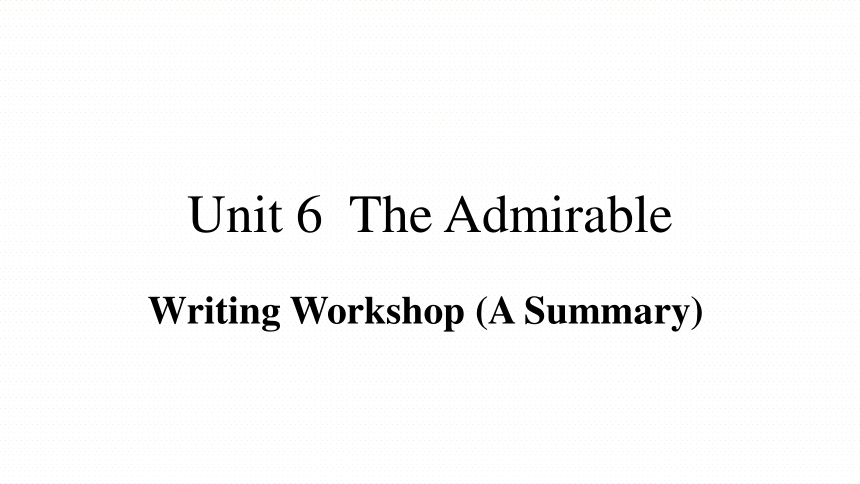 | |
| 格式 | pptx | ||
| 文件大小 | 803.0KB | ||
| 资源类型 | 教案 | ||
| 版本资源 | 北师大版(2019) | ||
| 科目 | 英语 | ||
| 更新时间 | 2022-06-17 08:45:45 | ||
图片预览


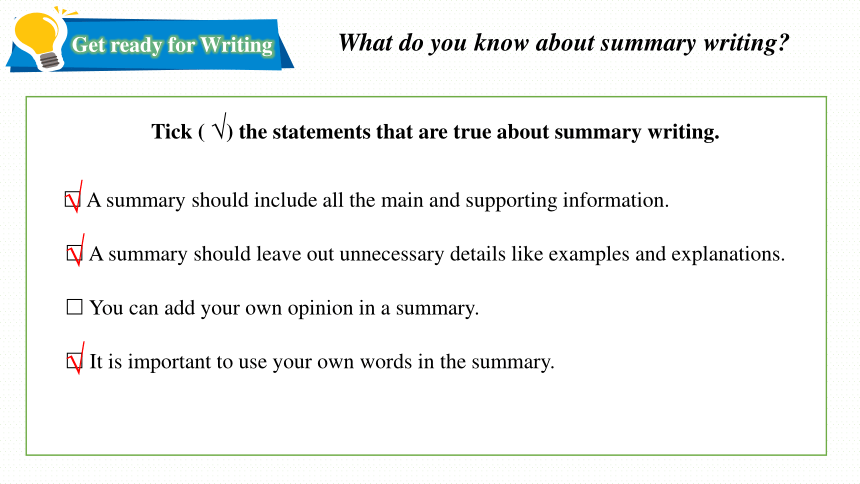
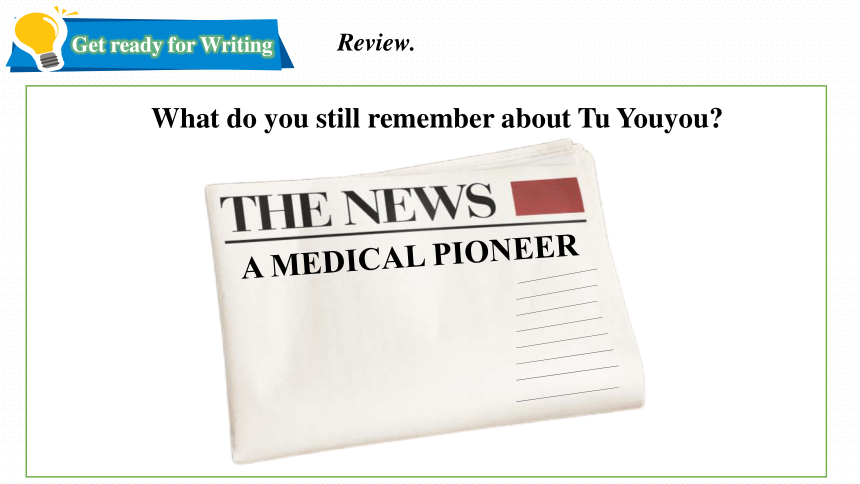


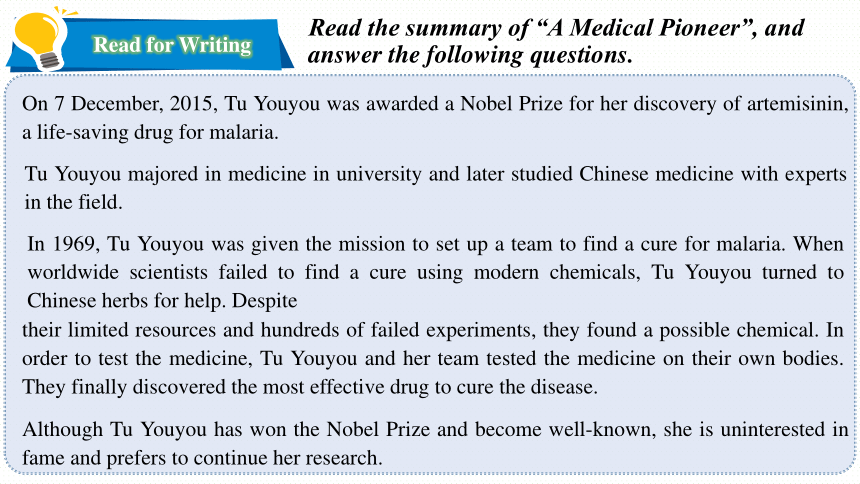
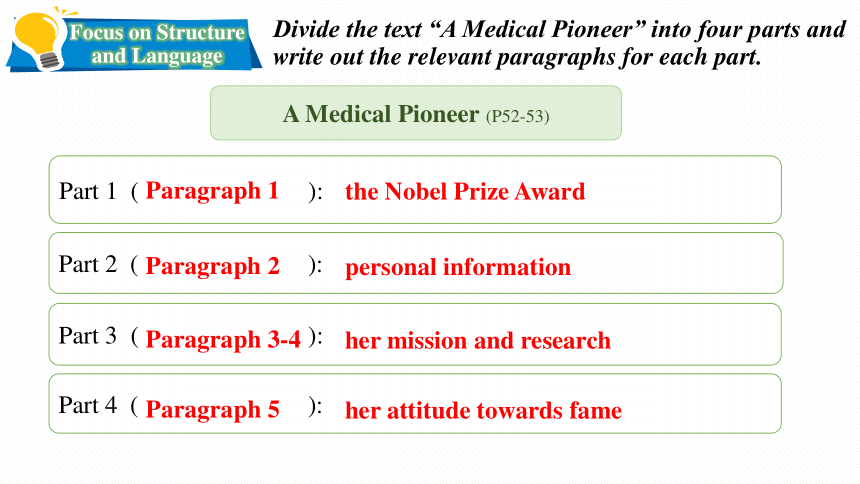
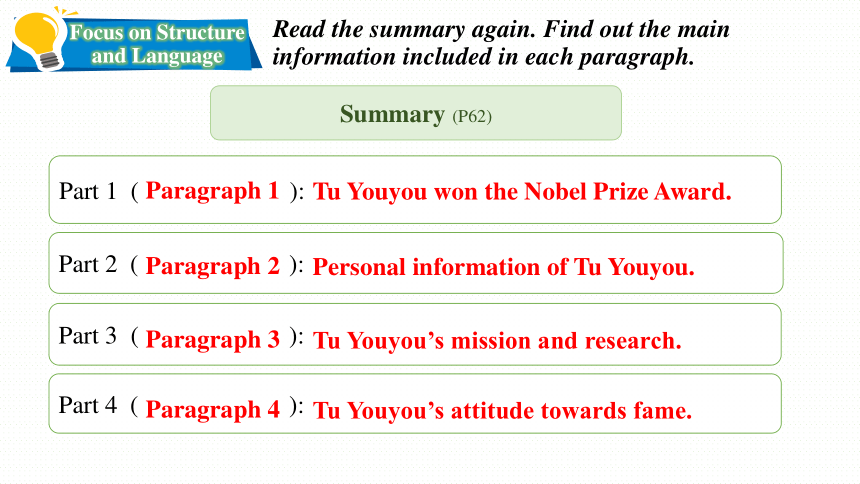
文档简介
(共26张PPT)
Unit 6 The Admirable
Writing Workshop (A Summary)
Background Knowledge
summary
a brief statement or an account of the main points of something
n. 概要;摘要;总结
What do you know about summary writing
Get ready for Writing
Tick ( √) the statements that are true about summary writing.
A summary should include all the main and supporting information.
A summary should leave out unnecessary details like examples and explanations.
You can add your own opinion in a summary.
It is important to use your own words in the summary.
√
√
√
Review.
Get ready for Writing
What do you still remember about Tu Youyou
A MEDICAL PIONEER
Review.
Get ready for Writing
Basic information
Scientific work
Attitudes
Won a Nobel Prize
Date of birth:
December 30,1930
Birthplace: Zhejiang Province, China
Education: Studying medicine at Peking University
Task: To find a cure for malaria
Difficulties: Limited resources
Research: Tested more than 240,000 chemicals; researched hundreds of traditional recipes;
Tested herself
Discovery : artemisinin
Towards the honor:
Not interested in fame;
Prefers to continue her research
Tu Youyou
Read the summary of “A Medical Pioneer”, and answer the following questions.
Read for Writing
1 What main points of the original text are included
2 What information of the original text is left out Why
3 Does the summary include the opinion of the summary writer
Read the summary of “A Medical Pioneer”, and answer the following questions.
Read for Writing
Although Tu Youyou has won the Nobel Prize and become well-known, she is uninterested in fame and prefers to continue her research.
On 7 December, 2015, Tu Youyou was awarded a Nobel Prize for her discovery of artemisinin, a life-saving drug for malaria.
Tu Youyou majored in medicine in university and later studied Chinese medicine with experts in the field.
In 1969, Tu Youyou was given the mission to set up a team to find a cure for malaria. When worldwide scientists failed to find a cure using modern chemicals, Tu Youyou turned to Chinese herbs for help. Despite
their limited resources and hundreds of failed experiments, they found a possible chemical. In order to test the medicine, Tu Youyou and her team tested the medicine on their own bodies. They finally discovered the most effective drug to cure the disease.
Divide the text “A Medical Pioneer” into four parts and write out the relevant paragraphs for each part.
Focus on Structure and Language
Part 1 ( ):
A Medical Pioneer (P52-53)
Part 2 ( ):
Part 3 ( ):
Part 4 ( ):
Paragraph 1
the Nobel Prize Award
Paragraph 2
personal information
Paragraph 3-4
her mission and research
Paragraph 5
her attitude towards fame
Read the summary again. Find out the main information included in each paragraph.
Focus on Structure and Language
Part 1 ( ):
Summary (P62)
Part 2 ( ):
Part 3 ( ):
Part 4 ( ):
Paragraph 1
Tu Youyou won the Nobel Prize Award.
Paragraph 2
Personal information of Tu Youyou.
Paragraph 3
Tu Youyou’s mission and research.
Paragraph 4
Tu Youyou’s attitude towards fame.
Compare and find the similarities and differences between the text and summary.
Focus on Structure and Language
On 7 December, 2015, Tu Youyou was awarded a Nobel Prize for her discovery of artemisinin, a life-saving drug for malaria.
At the Nobel Prize Lecture on 7 December, 2015, an 84-year-old Chinese woman walked slowly on to the stage. She began to talk about the life-saving drug, artemisinin, which she had discovered with the help of her team in the 1970s. The woman was Tu Youyou, the first Chinese female scientist to be awarded a Nobel Prize for her work. A scientist who was on the Nobel Prize Committee called Hans Forssberg explained that “the discovery of artemisinin has led to the development of new drugs which have saved the lives of millions”. When thanking the Committee for the honour, Tu Youyou said, “This is not only an honour for myself, but also recognition and encouragement for all scientists in China.”
Part 1: Tu Youyou’s winning of the Nobel Prize
Left out some details, explanations and quotes
Compare and find the similarities and differences between the text and summary.
Focus on Structure and Language
Tu Youyou majored in medicine in university and later studied Chinese medicine with experts in the field.
Tu Youyou was born in Zhejiang Province, China, on 30 December, 1930. She studied medicine at Peking University Health Science Centre. After graduation, she became a member of China Academy of Chinese Medical Sciences. Later, she studied Chinese medicine for two and a half years with experts in the field from whom she gained a deep knowledge about traditional practices.
Part 2: Tu Youyou’s personal information
Just introduced her experiences of studying medicine
Compare and find the similarities and differences between the text and summary.
Focus on Structure and Language
In 1969, Tu Youyou was given the mission to set up a team to find a cure for malaria. When worldwide scientists failed to find a cure using modern chemicals, Tu Youyou turned to Chinese herbs for help.
In 1969, Tu Youyou was chosen to establish a team to find a cure for malaria — a disease that killed millions of people every year. Across the world, scientists had been trying to find a cure. They tested more than 240,000 chemicals with no success. However, Tu Youyou had an idea that Chinese herbs might hold the secret. She studied ancient Chinese medical literature and visited experts in traditional Chinese medicine. She researched hundreds of traditional recipes connected to anti-malarial cures. Then Tu Youyou and her team began using modern research methods to study these Chinese herbs one by one.
Part 3: Tu Youyou’s mission and research
Just introduced her mission and the background of her research
Compare and find the similarities and differences between the text and summary.
Focus on Structure and Language
Despite their limited resources and hundreds of failed experiments, they found a possible chemical. In order to test the medicine, Tu Youyou and her team tested the medicine on their own bodies. They finally discovered the most effective drug to cure the disease.
This was not an easy task. The reason why this was difficult was that the team had limited resources. They did not have enough staff, and the laboratory in which they worked had poor air quality. However, after hundreds of failed experiments, they eventually came across a promising chemical. It worked well in experiments on animals, but they had to know if it was safe for humans. Tu Youyou bravely volunteered to be the first human subject when they were ready to start testing and the rest of her team followed her. The test was a success. The medicine they discovered, artemisinin, has now become the world’s most effective drug for fighting malaria.
Part 3: Tu Youyou’s mission and research
Introduced more details about her research
Compare and find the similarities and differences between the text and summary.
Focus on Structure and Language
Although Tu Youyou has won the Nobel Prize and become well-known, she is uninterested in fame and prefers to continue her research.
Even though Tu Youyou is not interested in fame, she has become a scientist whose work is internationally renowned. In 2019, she was selected by the BBC as one of the most influential figures of science in the 20th Century along with Albert Einstein and Alan Mathison Turing. Tu Youyou was noted for her bravery in being a scientist during a difficult time for science in China, her ability to use old wisdom and new methods to achieve her goals and the fact that her work bridged the Eastern and Western worlds, saving millions of lives. Today Tu Youyou continues to conduct research despite her age. According to Tu Youyou, “From our research experience in discovering artemisinin, we learnt the wisdom behind both Chinese and Western medicine. There is great potential for future advances if these two kinds of wisdom can be fully integrated,” she said.
Part 4: Tu Youyou’s attitude towards fame
Introduced more about her achievement
Similarities and differences
Read for Writing
The structure
Main points
Similarities
Differences
Some information is left out.
Some expressions are replaced with synonyms.
Read the summary of “A Medical Pioneer”, and answer the following questions.
Read for Writing
1 What main points of the original text are included
2 What information of the original text is left out Why
3 Does the summary include the opinion of the summary writer
Tu Youyou’s achievement of winning the Nobel Prize, her education background, her mission of finding a cure for malaria, her research, and her attitude towards fame are included.
Tu Youyou’s biography and details of her work are left out, because a summary should be short and concise.
No. It doesn’t include the opinion of the writer.
Read “ The Superhero Behind Superman”. How many parts can it be divided into What does each part focus on
Focus on Structure and Language
Part 1 ( ):
The Superhero Behind Superman (P58-59)
Part 2 ( ):
Part 3 ( ):
Part 4 ( ):
Paragraph 1
general introduction
Paragraph 2-3
life before the accident
Paragraph 4-5
a superhero in real life
Paragraph 6
his death
Read the following paragraph and underline the key words to get the main idea.
Then summarise the paragraph in one sentence.
Focus on Structure and Language
Reeve starred in four Superman films from 1978 to 1987. He realised that his roles in these films had given him the opportunity to be a real-life superman, and he soon gained a reputation for raising awareness for good causes. He visited sick children in hospitals and worked with organisations such as Save the Children, speaking out about health, education and child protection to help those most in need.
Summary
Reeve starred in four Superman films from 1978 to 1987, which had given him the opportunity to be a real-life superman, and he soon gained a reputation for his charity work.
Let’s summarise the main idea of the other parts of the text.
Focus on Structure and Language
Summary
Christopher Reeve is not only known as a superhero in the Superman films but also regarded as a superhero in real life.
The story of Christopher Reeve’s life is one that is almost impossible to imagine — from a wildly successful Hollywood career, to the horror of life-threatening injury; Reeve experienced both. Thus, not only is he known as a superhero in the Superman films, but he is also regarded as a superhero to many in real life.
Part 1 (Paragraph 1) general introduction
Let’s summarise the main idea of the other parts of the text.
Focus on Structure and Language
Summary
Reeve was born on 25 September, 1952 in New York. He found his passion in acting at the age of eight and eventually starred in a Superman film as a lead role.
Part 2 (Paragraph 2) life before the accident
Reeve was born on 25 September,1952 in New York — the son of Franklin Reeve, a teacher and novelist, and Barbara Pitney, a journalist. He found his passion in acting and starred in his first school play at the age of eight. Although he believed he would only ever act on stage, Reeve tried out for, and was eventually given the lead role in a Superman film.
Read the following paragraph and underline the key words to get the main idea.
Then summarise the paragraph in one sentence.
Focus on Structure and Language
Reeve starred in four Superman films from 1978 to 1987. He realised that his roles in these films had given him the opportunity to be a real-life superman, and he soon gained a reputation for raising awareness for good causes. He visited sick children in hospitals and worked with organisations such as Save the Children, speaking out about health, education and child protection to help those most in need.
Summary
Reeve starred in four Superman films from 1978 to 1987, which had given him the opportunity to be a real-life superman, and he soon gained a reputation for his charity work.
Part 2 (Paragraph 3) life before the accident
Read the following paragraph and underline the key words to get the main idea.
Then summarise the paragraph in one sentence.
Focus on Structure and Language
Unfortunately, in 1995 disaster struck Reeve. While horseback riding, he was thrown off his horse and broke his neck. His injuries were so severe that he had no movement or feeling in his body at all and even needed a machine to help him breathe. At first, his doctors did not believe that he would survive. During this time, Reeve felt like he had lost all hope. Having once been a healthy and successful young man to being trapped in a broken body was like a living nightmare to him. He admitted that during the early stages of living with his injury, he wished that he was dead and even thought of ending his own life. He fell into a depression which lasted for many months. It was only due to the ongoing support of his wife, family and friends that he eventually found the will to live again. For the years that followed he focused his attention on his goal of one day walking again.
Part 3 (Paragraph 4) a superhero in real life
Summary
Unfortunately, in 1995 disaster struck Reeve. His severe injuries made him lose all hope during the early stages. But eventually he found a will to live again and set a goal of one day walking because of the support of his family and friends.
Read the following paragraph and underline the key words to get the main idea.
Then summarise the paragraph in one sentence.
Focus on Structure and Language
With a new sense of energy and commitment, Reeve undertook an intense exercise programme to help him achieve this goal. He engaged in a wide range of exercises designed to rebuild muscle, and made remarkable progress. Shortly after, he managed to return to his film career by directing, producing and even starring in films. He also wrote a biography and returned to his charity work. Reeve became a passionate and energetic advocate for people with back injuries and disabilities, raising millions of dollars in support of medical research. “What I do is based on powers we all have inside us ... and you don’t have to be a ‘superman’ to do it.” His positive attitude inspired many people who were stuck in illness. “With the progress of new medical research, I’m confident that people like me would be able to walk again one day. So you can see, I’m too busy with living to think of giving up!”
Part 3 (Paragraph 5) a superhero in real life
Summary
To achieve his goal, Reeve undertook an intense programme. Finally he managed to return to his film career, wrote a biography and did charity work again, which inspired a lot of people in real life.
Let’s summarise the main idea of the other parts of the text.
Focus on Structure and Language
Summary
Sadly, on 10 October, 2004, Christopher Reeve passed away. But he will always be remembered as a superhero.
Part 4 (Paragraph 6) his death
Sadly, on 10 October, 2004, Christopher Reeve passed away. He will always be remembered as a superhero — in more ways than one.
The summary of “The Superhero Behind Superman”
Christopher Reeve is not only known as a superhero in the Superman films but also regarded as a superhero in real life.
Reeve was born on 25 September, 1952 in New York. He found his passion in acting at the age of eight and eventually starred in a Superman film as a lead role. Reeve starred in four Superman films from 1978 to 1987, which had given him the opportunity to be a real-life superman, and he soon gained a reputation for his charity work.
Unfortunately, in 1995 disaster struck Reeve. His severe injuries made him lose all hope during the early stages. But eventually he found a will to live again and set a goal of one day walking because of the support of his family and friends. To achieve his goal, Reeve undertook an intense programme. Finally he managed to return to his film career, wrote a biography and did charity work again, which inspired a lot of people in real life.
Sadly, on 10 October, 2004, Christopher Reeve passed away. But he will always be remembered as a superhero.
Thank You
Unit 6 The Admirable
Writing Workshop (A Summary)
Background Knowledge
summary
a brief statement or an account of the main points of something
n. 概要;摘要;总结
What do you know about summary writing
Get ready for Writing
Tick ( √) the statements that are true about summary writing.
A summary should include all the main and supporting information.
A summary should leave out unnecessary details like examples and explanations.
You can add your own opinion in a summary.
It is important to use your own words in the summary.
√
√
√
Review.
Get ready for Writing
What do you still remember about Tu Youyou
A MEDICAL PIONEER
Review.
Get ready for Writing
Basic information
Scientific work
Attitudes
Won a Nobel Prize
Date of birth:
December 30,1930
Birthplace: Zhejiang Province, China
Education: Studying medicine at Peking University
Task: To find a cure for malaria
Difficulties: Limited resources
Research: Tested more than 240,000 chemicals; researched hundreds of traditional recipes;
Tested herself
Discovery : artemisinin
Towards the honor:
Not interested in fame;
Prefers to continue her research
Tu Youyou
Read the summary of “A Medical Pioneer”, and answer the following questions.
Read for Writing
1 What main points of the original text are included
2 What information of the original text is left out Why
3 Does the summary include the opinion of the summary writer
Read the summary of “A Medical Pioneer”, and answer the following questions.
Read for Writing
Although Tu Youyou has won the Nobel Prize and become well-known, she is uninterested in fame and prefers to continue her research.
On 7 December, 2015, Tu Youyou was awarded a Nobel Prize for her discovery of artemisinin, a life-saving drug for malaria.
Tu Youyou majored in medicine in university and later studied Chinese medicine with experts in the field.
In 1969, Tu Youyou was given the mission to set up a team to find a cure for malaria. When worldwide scientists failed to find a cure using modern chemicals, Tu Youyou turned to Chinese herbs for help. Despite
their limited resources and hundreds of failed experiments, they found a possible chemical. In order to test the medicine, Tu Youyou and her team tested the medicine on their own bodies. They finally discovered the most effective drug to cure the disease.
Divide the text “A Medical Pioneer” into four parts and write out the relevant paragraphs for each part.
Focus on Structure and Language
Part 1 ( ):
A Medical Pioneer (P52-53)
Part 2 ( ):
Part 3 ( ):
Part 4 ( ):
Paragraph 1
the Nobel Prize Award
Paragraph 2
personal information
Paragraph 3-4
her mission and research
Paragraph 5
her attitude towards fame
Read the summary again. Find out the main information included in each paragraph.
Focus on Structure and Language
Part 1 ( ):
Summary (P62)
Part 2 ( ):
Part 3 ( ):
Part 4 ( ):
Paragraph 1
Tu Youyou won the Nobel Prize Award.
Paragraph 2
Personal information of Tu Youyou.
Paragraph 3
Tu Youyou’s mission and research.
Paragraph 4
Tu Youyou’s attitude towards fame.
Compare and find the similarities and differences between the text and summary.
Focus on Structure and Language
On 7 December, 2015, Tu Youyou was awarded a Nobel Prize for her discovery of artemisinin, a life-saving drug for malaria.
At the Nobel Prize Lecture on 7 December, 2015, an 84-year-old Chinese woman walked slowly on to the stage. She began to talk about the life-saving drug, artemisinin, which she had discovered with the help of her team in the 1970s. The woman was Tu Youyou, the first Chinese female scientist to be awarded a Nobel Prize for her work. A scientist who was on the Nobel Prize Committee called Hans Forssberg explained that “the discovery of artemisinin has led to the development of new drugs which have saved the lives of millions”. When thanking the Committee for the honour, Tu Youyou said, “This is not only an honour for myself, but also recognition and encouragement for all scientists in China.”
Part 1: Tu Youyou’s winning of the Nobel Prize
Left out some details, explanations and quotes
Compare and find the similarities and differences between the text and summary.
Focus on Structure and Language
Tu Youyou majored in medicine in university and later studied Chinese medicine with experts in the field.
Tu Youyou was born in Zhejiang Province, China, on 30 December, 1930. She studied medicine at Peking University Health Science Centre. After graduation, she became a member of China Academy of Chinese Medical Sciences. Later, she studied Chinese medicine for two and a half years with experts in the field from whom she gained a deep knowledge about traditional practices.
Part 2: Tu Youyou’s personal information
Just introduced her experiences of studying medicine
Compare and find the similarities and differences between the text and summary.
Focus on Structure and Language
In 1969, Tu Youyou was given the mission to set up a team to find a cure for malaria. When worldwide scientists failed to find a cure using modern chemicals, Tu Youyou turned to Chinese herbs for help.
In 1969, Tu Youyou was chosen to establish a team to find a cure for malaria — a disease that killed millions of people every year. Across the world, scientists had been trying to find a cure. They tested more than 240,000 chemicals with no success. However, Tu Youyou had an idea that Chinese herbs might hold the secret. She studied ancient Chinese medical literature and visited experts in traditional Chinese medicine. She researched hundreds of traditional recipes connected to anti-malarial cures. Then Tu Youyou and her team began using modern research methods to study these Chinese herbs one by one.
Part 3: Tu Youyou’s mission and research
Just introduced her mission and the background of her research
Compare and find the similarities and differences between the text and summary.
Focus on Structure and Language
Despite their limited resources and hundreds of failed experiments, they found a possible chemical. In order to test the medicine, Tu Youyou and her team tested the medicine on their own bodies. They finally discovered the most effective drug to cure the disease.
This was not an easy task. The reason why this was difficult was that the team had limited resources. They did not have enough staff, and the laboratory in which they worked had poor air quality. However, after hundreds of failed experiments, they eventually came across a promising chemical. It worked well in experiments on animals, but they had to know if it was safe for humans. Tu Youyou bravely volunteered to be the first human subject when they were ready to start testing and the rest of her team followed her. The test was a success. The medicine they discovered, artemisinin, has now become the world’s most effective drug for fighting malaria.
Part 3: Tu Youyou’s mission and research
Introduced more details about her research
Compare and find the similarities and differences between the text and summary.
Focus on Structure and Language
Although Tu Youyou has won the Nobel Prize and become well-known, she is uninterested in fame and prefers to continue her research.
Even though Tu Youyou is not interested in fame, she has become a scientist whose work is internationally renowned. In 2019, she was selected by the BBC as one of the most influential figures of science in the 20th Century along with Albert Einstein and Alan Mathison Turing. Tu Youyou was noted for her bravery in being a scientist during a difficult time for science in China, her ability to use old wisdom and new methods to achieve her goals and the fact that her work bridged the Eastern and Western worlds, saving millions of lives. Today Tu Youyou continues to conduct research despite her age. According to Tu Youyou, “From our research experience in discovering artemisinin, we learnt the wisdom behind both Chinese and Western medicine. There is great potential for future advances if these two kinds of wisdom can be fully integrated,” she said.
Part 4: Tu Youyou’s attitude towards fame
Introduced more about her achievement
Similarities and differences
Read for Writing
The structure
Main points
Similarities
Differences
Some information is left out.
Some expressions are replaced with synonyms.
Read the summary of “A Medical Pioneer”, and answer the following questions.
Read for Writing
1 What main points of the original text are included
2 What information of the original text is left out Why
3 Does the summary include the opinion of the summary writer
Tu Youyou’s achievement of winning the Nobel Prize, her education background, her mission of finding a cure for malaria, her research, and her attitude towards fame are included.
Tu Youyou’s biography and details of her work are left out, because a summary should be short and concise.
No. It doesn’t include the opinion of the writer.
Read “ The Superhero Behind Superman”. How many parts can it be divided into What does each part focus on
Focus on Structure and Language
Part 1 ( ):
The Superhero Behind Superman (P58-59)
Part 2 ( ):
Part 3 ( ):
Part 4 ( ):
Paragraph 1
general introduction
Paragraph 2-3
life before the accident
Paragraph 4-5
a superhero in real life
Paragraph 6
his death
Read the following paragraph and underline the key words to get the main idea.
Then summarise the paragraph in one sentence.
Focus on Structure and Language
Reeve starred in four Superman films from 1978 to 1987. He realised that his roles in these films had given him the opportunity to be a real-life superman, and he soon gained a reputation for raising awareness for good causes. He visited sick children in hospitals and worked with organisations such as Save the Children, speaking out about health, education and child protection to help those most in need.
Summary
Reeve starred in four Superman films from 1978 to 1987, which had given him the opportunity to be a real-life superman, and he soon gained a reputation for his charity work.
Let’s summarise the main idea of the other parts of the text.
Focus on Structure and Language
Summary
Christopher Reeve is not only known as a superhero in the Superman films but also regarded as a superhero in real life.
The story of Christopher Reeve’s life is one that is almost impossible to imagine — from a wildly successful Hollywood career, to the horror of life-threatening injury; Reeve experienced both. Thus, not only is he known as a superhero in the Superman films, but he is also regarded as a superhero to many in real life.
Part 1 (Paragraph 1) general introduction
Let’s summarise the main idea of the other parts of the text.
Focus on Structure and Language
Summary
Reeve was born on 25 September, 1952 in New York. He found his passion in acting at the age of eight and eventually starred in a Superman film as a lead role.
Part 2 (Paragraph 2) life before the accident
Reeve was born on 25 September,1952 in New York — the son of Franklin Reeve, a teacher and novelist, and Barbara Pitney, a journalist. He found his passion in acting and starred in his first school play at the age of eight. Although he believed he would only ever act on stage, Reeve tried out for, and was eventually given the lead role in a Superman film.
Read the following paragraph and underline the key words to get the main idea.
Then summarise the paragraph in one sentence.
Focus on Structure and Language
Reeve starred in four Superman films from 1978 to 1987. He realised that his roles in these films had given him the opportunity to be a real-life superman, and he soon gained a reputation for raising awareness for good causes. He visited sick children in hospitals and worked with organisations such as Save the Children, speaking out about health, education and child protection to help those most in need.
Summary
Reeve starred in four Superman films from 1978 to 1987, which had given him the opportunity to be a real-life superman, and he soon gained a reputation for his charity work.
Part 2 (Paragraph 3) life before the accident
Read the following paragraph and underline the key words to get the main idea.
Then summarise the paragraph in one sentence.
Focus on Structure and Language
Unfortunately, in 1995 disaster struck Reeve. While horseback riding, he was thrown off his horse and broke his neck. His injuries were so severe that he had no movement or feeling in his body at all and even needed a machine to help him breathe. At first, his doctors did not believe that he would survive. During this time, Reeve felt like he had lost all hope. Having once been a healthy and successful young man to being trapped in a broken body was like a living nightmare to him. He admitted that during the early stages of living with his injury, he wished that he was dead and even thought of ending his own life. He fell into a depression which lasted for many months. It was only due to the ongoing support of his wife, family and friends that he eventually found the will to live again. For the years that followed he focused his attention on his goal of one day walking again.
Part 3 (Paragraph 4) a superhero in real life
Summary
Unfortunately, in 1995 disaster struck Reeve. His severe injuries made him lose all hope during the early stages. But eventually he found a will to live again and set a goal of one day walking because of the support of his family and friends.
Read the following paragraph and underline the key words to get the main idea.
Then summarise the paragraph in one sentence.
Focus on Structure and Language
With a new sense of energy and commitment, Reeve undertook an intense exercise programme to help him achieve this goal. He engaged in a wide range of exercises designed to rebuild muscle, and made remarkable progress. Shortly after, he managed to return to his film career by directing, producing and even starring in films. He also wrote a biography and returned to his charity work. Reeve became a passionate and energetic advocate for people with back injuries and disabilities, raising millions of dollars in support of medical research. “What I do is based on powers we all have inside us ... and you don’t have to be a ‘superman’ to do it.” His positive attitude inspired many people who were stuck in illness. “With the progress of new medical research, I’m confident that people like me would be able to walk again one day. So you can see, I’m too busy with living to think of giving up!”
Part 3 (Paragraph 5) a superhero in real life
Summary
To achieve his goal, Reeve undertook an intense programme. Finally he managed to return to his film career, wrote a biography and did charity work again, which inspired a lot of people in real life.
Let’s summarise the main idea of the other parts of the text.
Focus on Structure and Language
Summary
Sadly, on 10 October, 2004, Christopher Reeve passed away. But he will always be remembered as a superhero.
Part 4 (Paragraph 6) his death
Sadly, on 10 October, 2004, Christopher Reeve passed away. He will always be remembered as a superhero — in more ways than one.
The summary of “The Superhero Behind Superman”
Christopher Reeve is not only known as a superhero in the Superman films but also regarded as a superhero in real life.
Reeve was born on 25 September, 1952 in New York. He found his passion in acting at the age of eight and eventually starred in a Superman film as a lead role. Reeve starred in four Superman films from 1978 to 1987, which had given him the opportunity to be a real-life superman, and he soon gained a reputation for his charity work.
Unfortunately, in 1995 disaster struck Reeve. His severe injuries made him lose all hope during the early stages. But eventually he found a will to live again and set a goal of one day walking because of the support of his family and friends. To achieve his goal, Reeve undertook an intense programme. Finally he managed to return to his film career, wrote a biography and did charity work again, which inspired a lot of people in real life.
Sadly, on 10 October, 2004, Christopher Reeve passed away. But he will always be remembered as a superhero.
Thank You
同课章节目录
- Unit 4 Information technology
- Lesson 1 Avatars
- Lesson 2 Apps
- Lesson 3 Internet and Friendships
- Unit 5 Humans and nature
- Lesson 1 A Sea Story
- Lesson 2 Professional Rescue Team
- Lesson 3 Race to the Pole
- Unit 6 The admirable
- Lesson 1 A Medical Pioneer
- Lesson 2 History Makers
- Lesson 3 The Superhero Behind Superman
